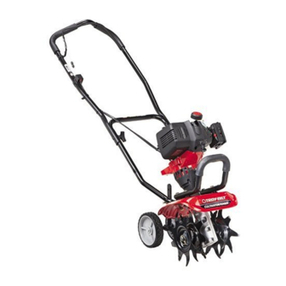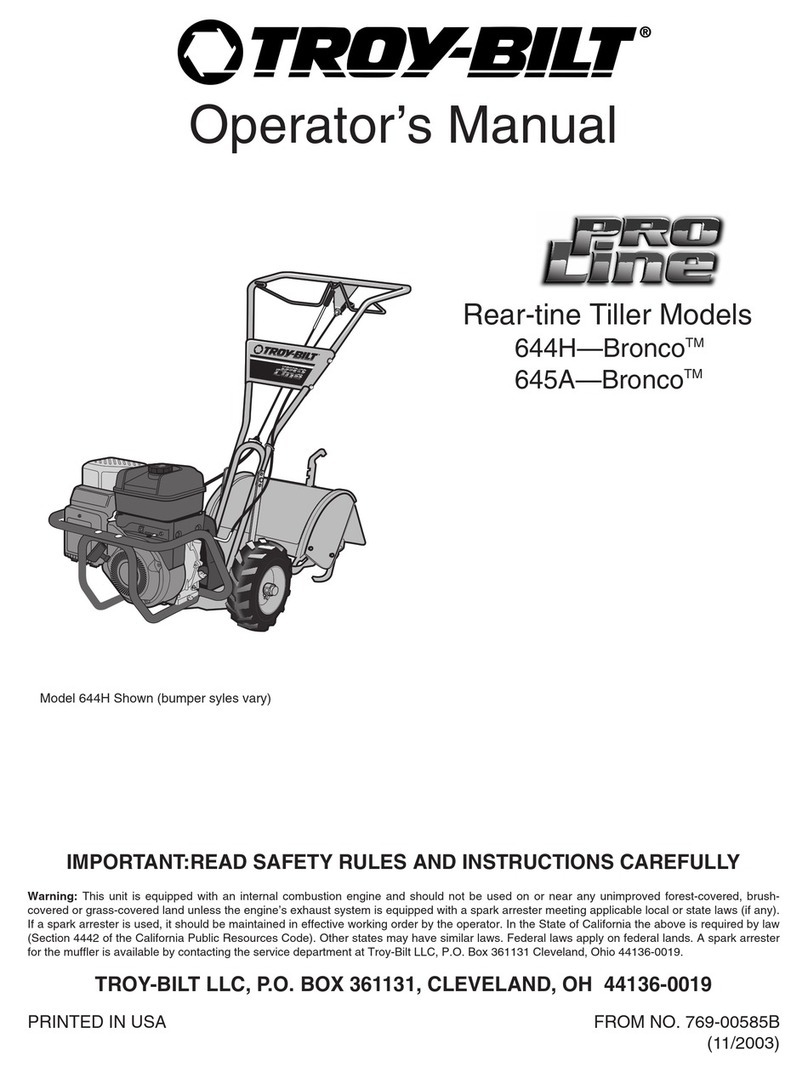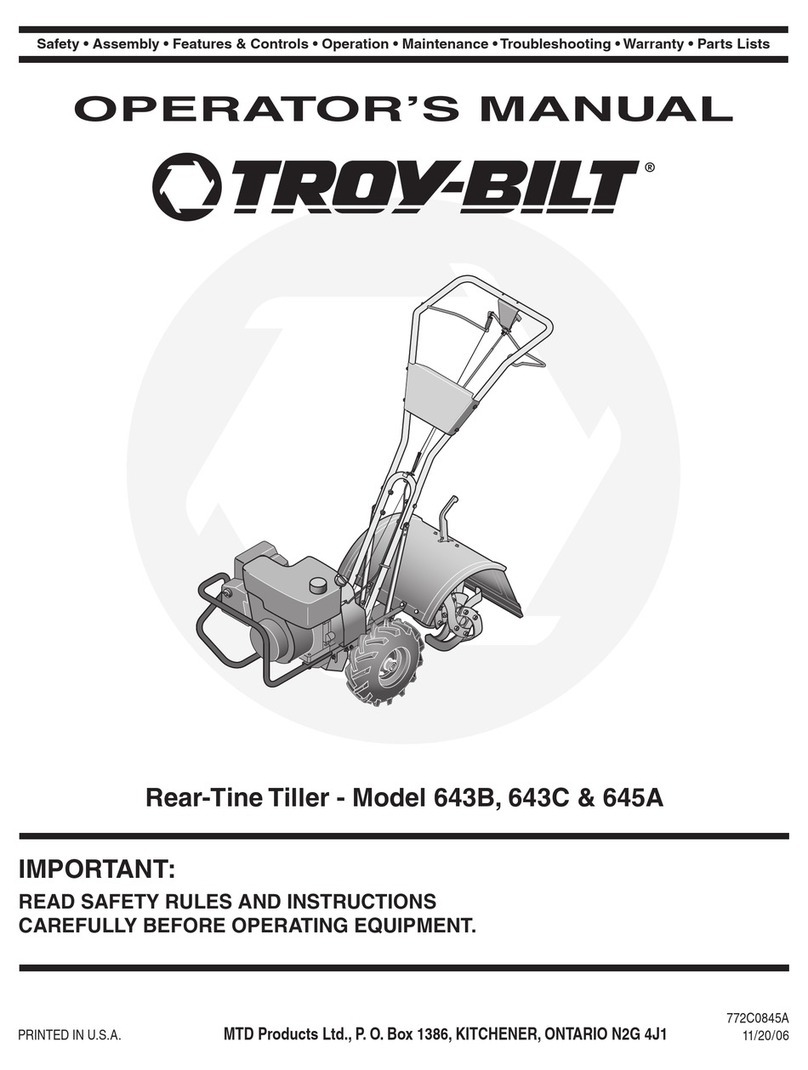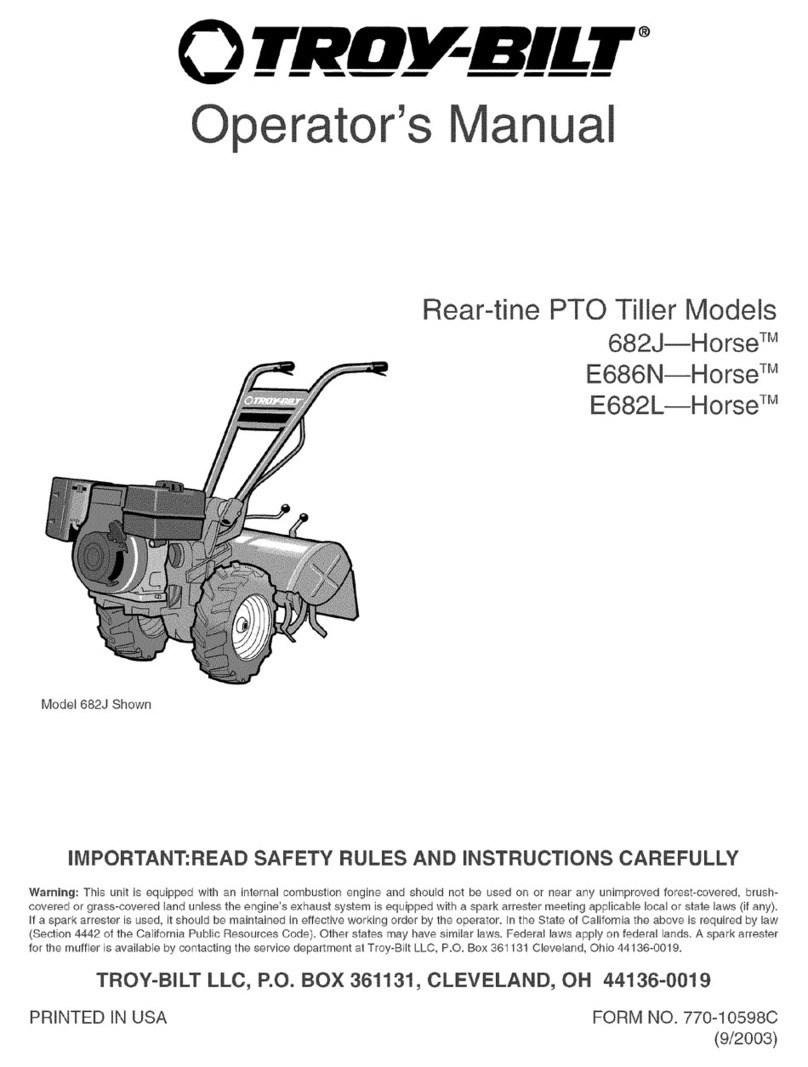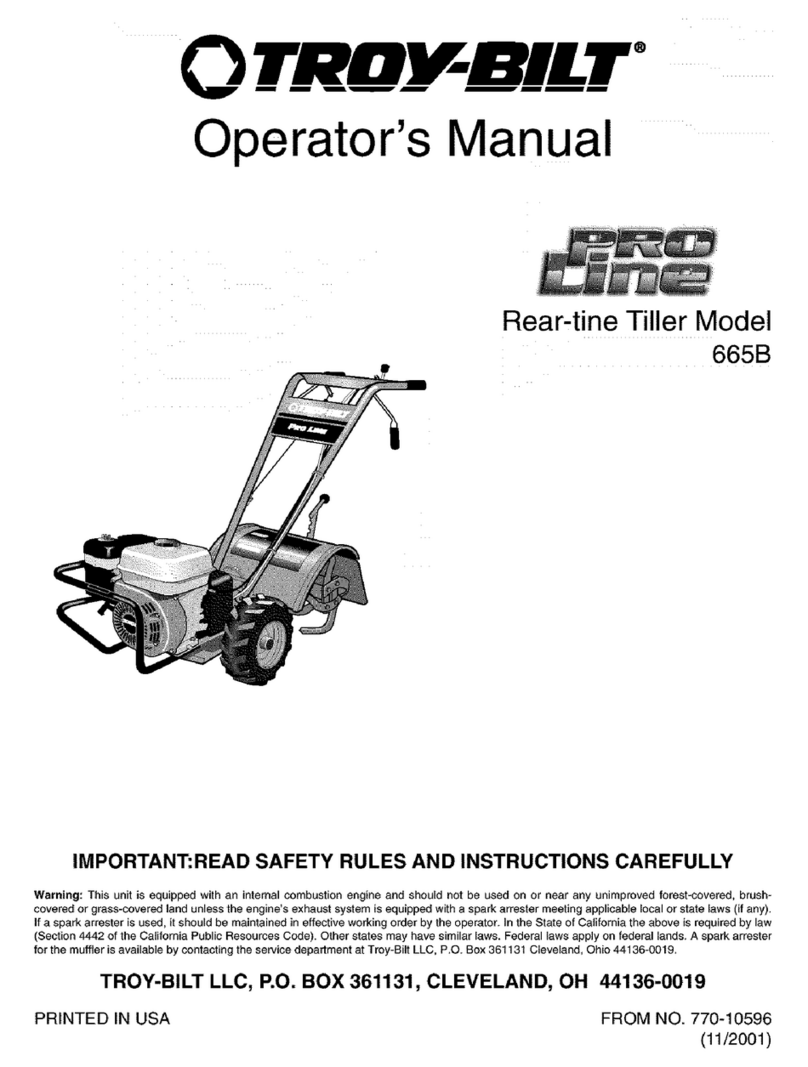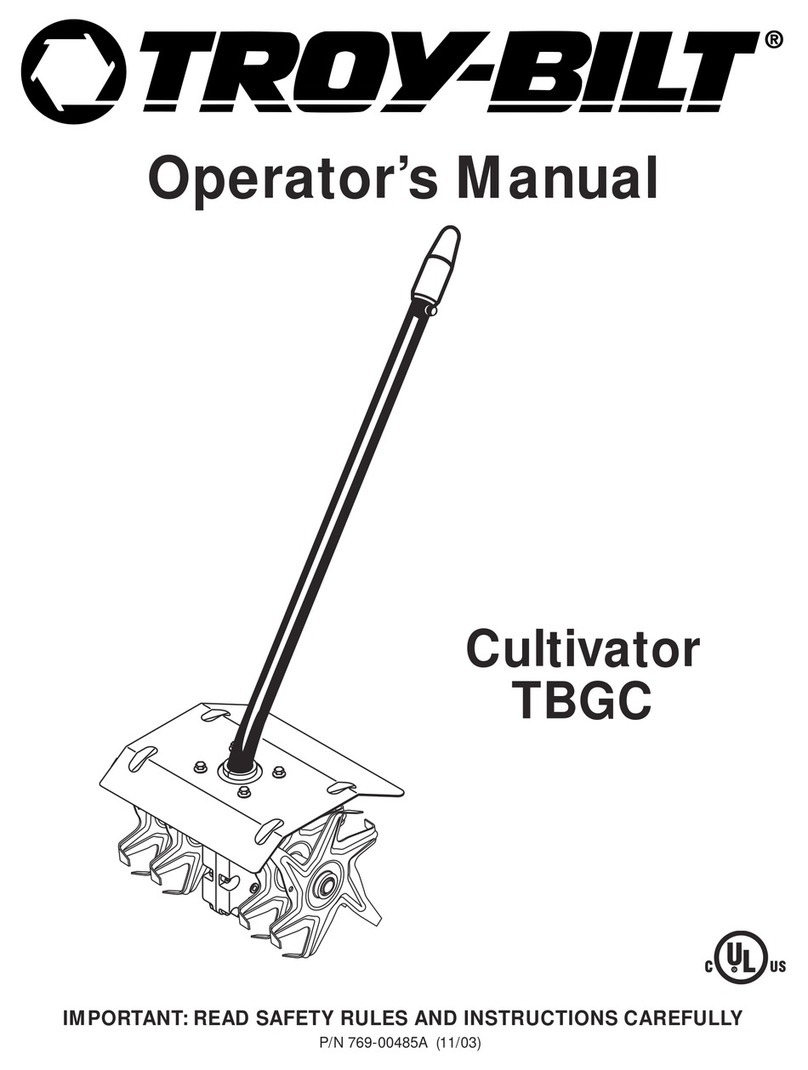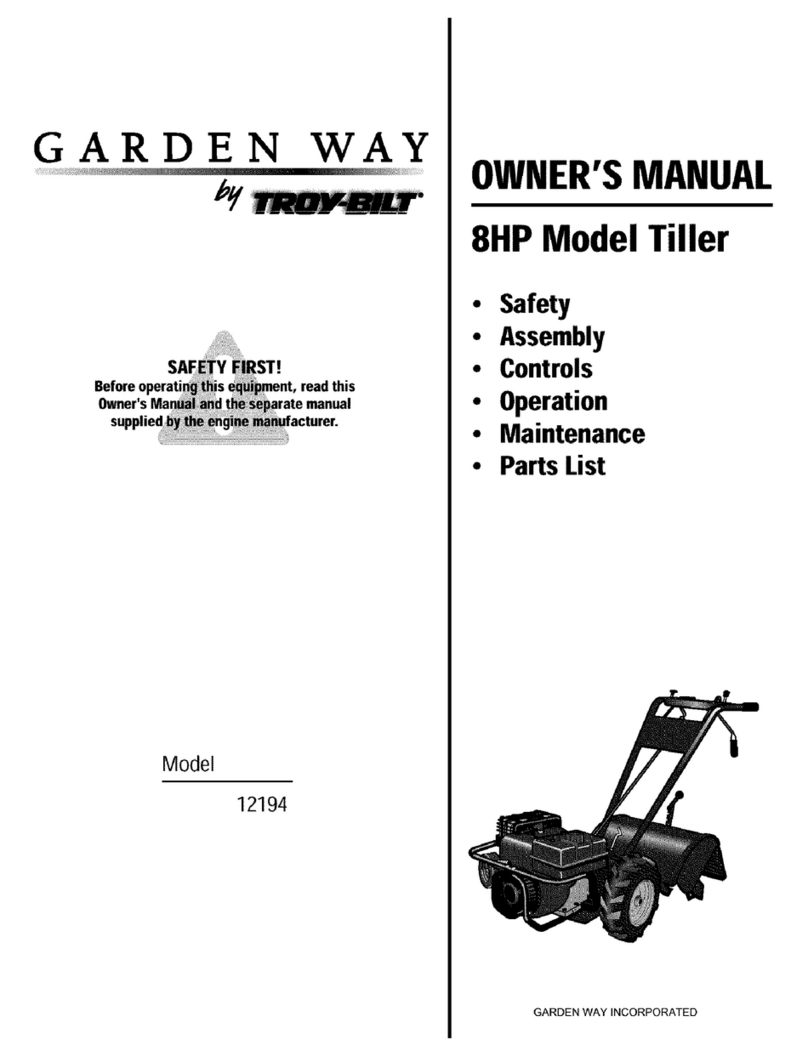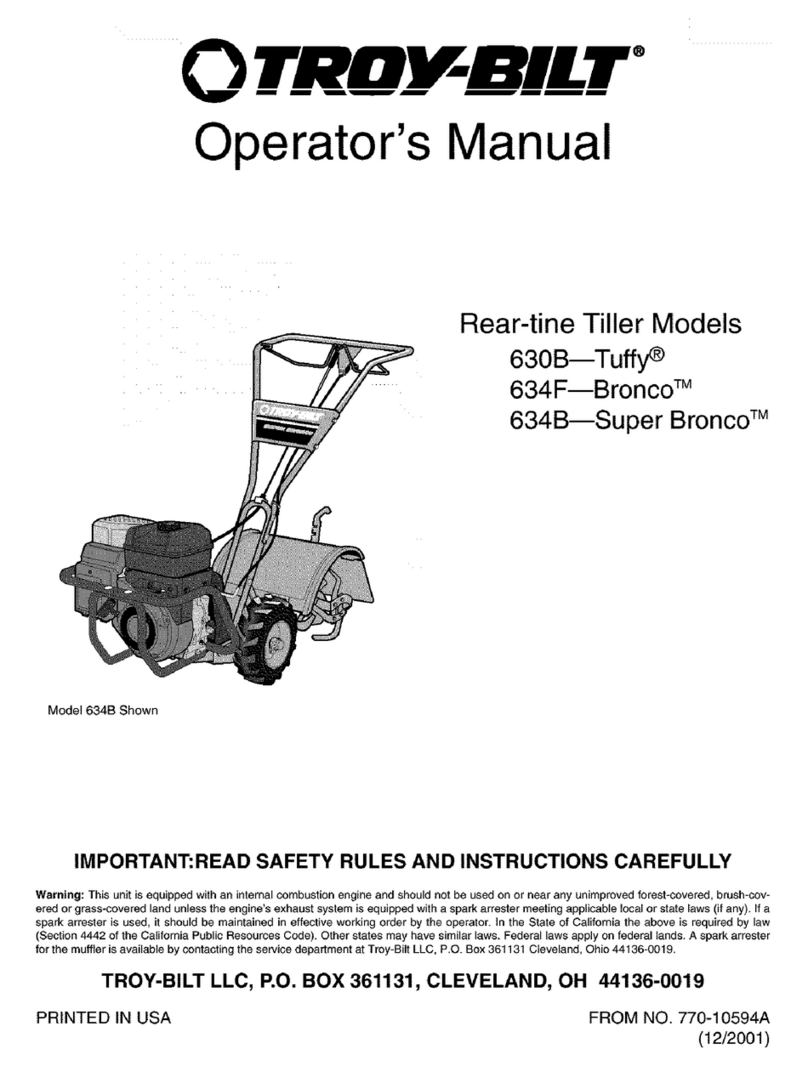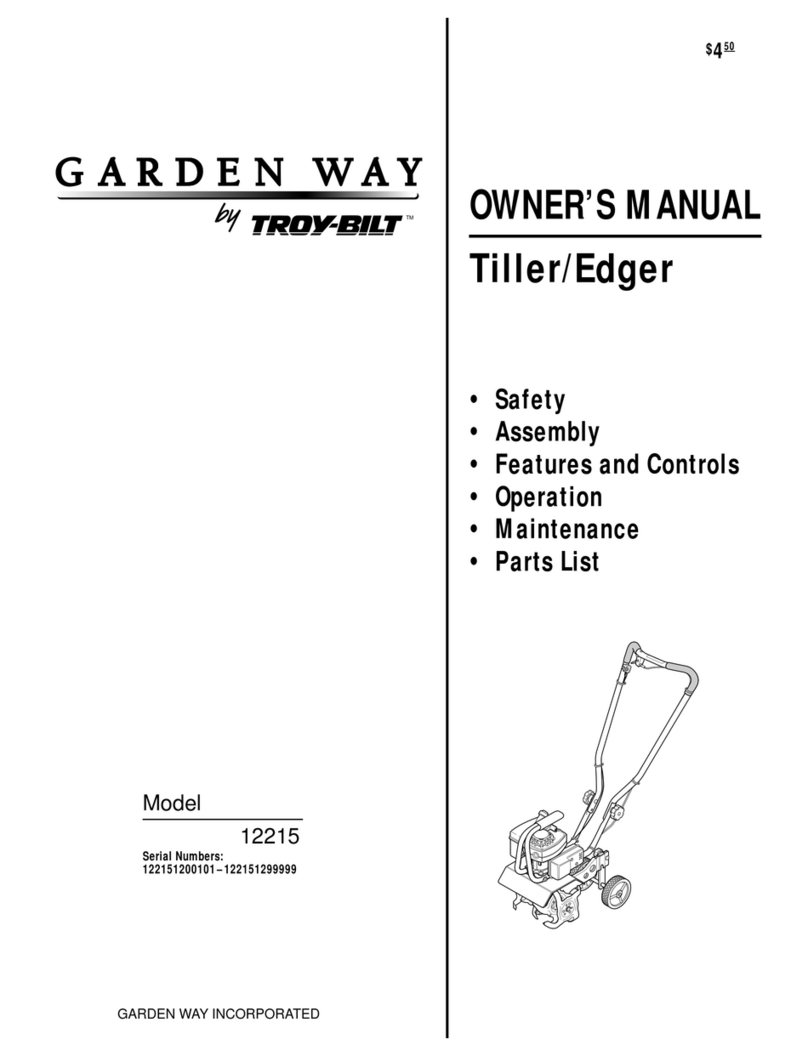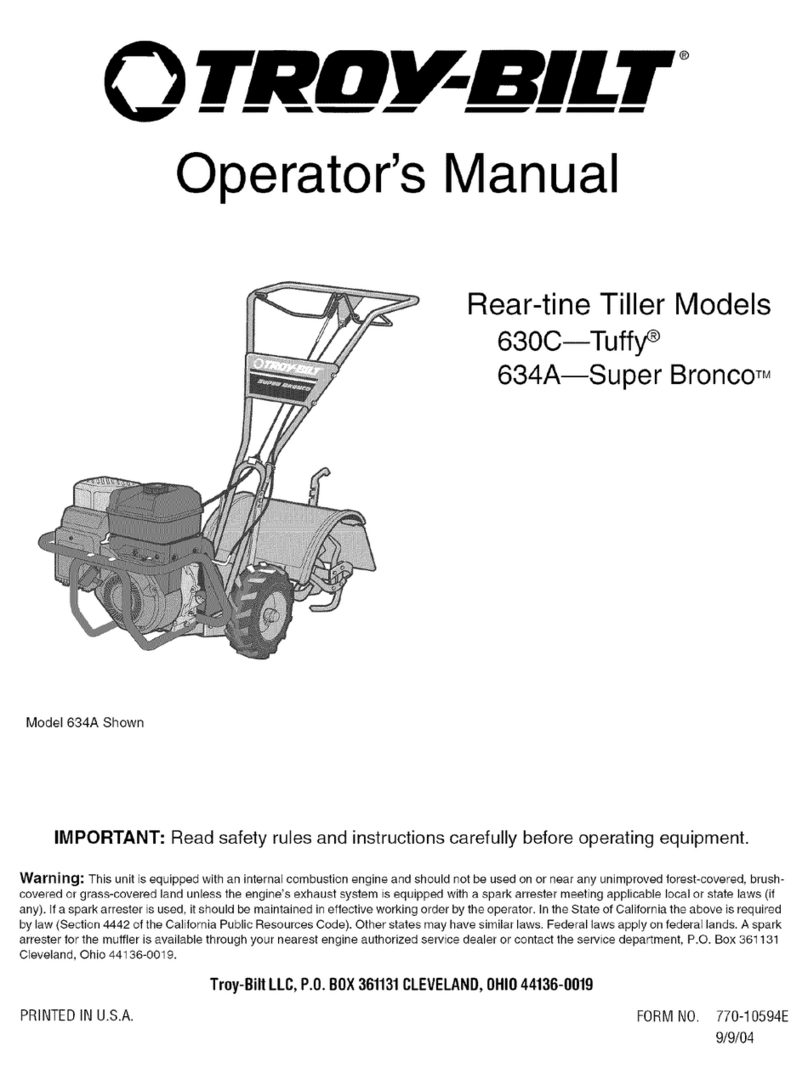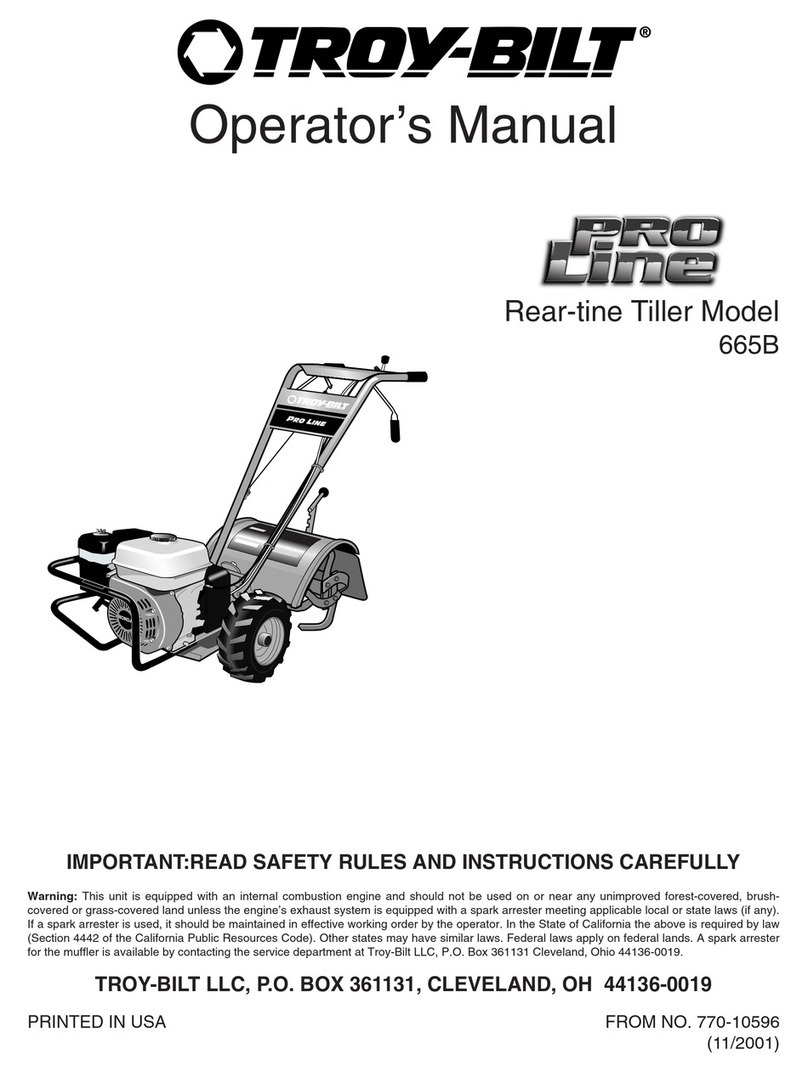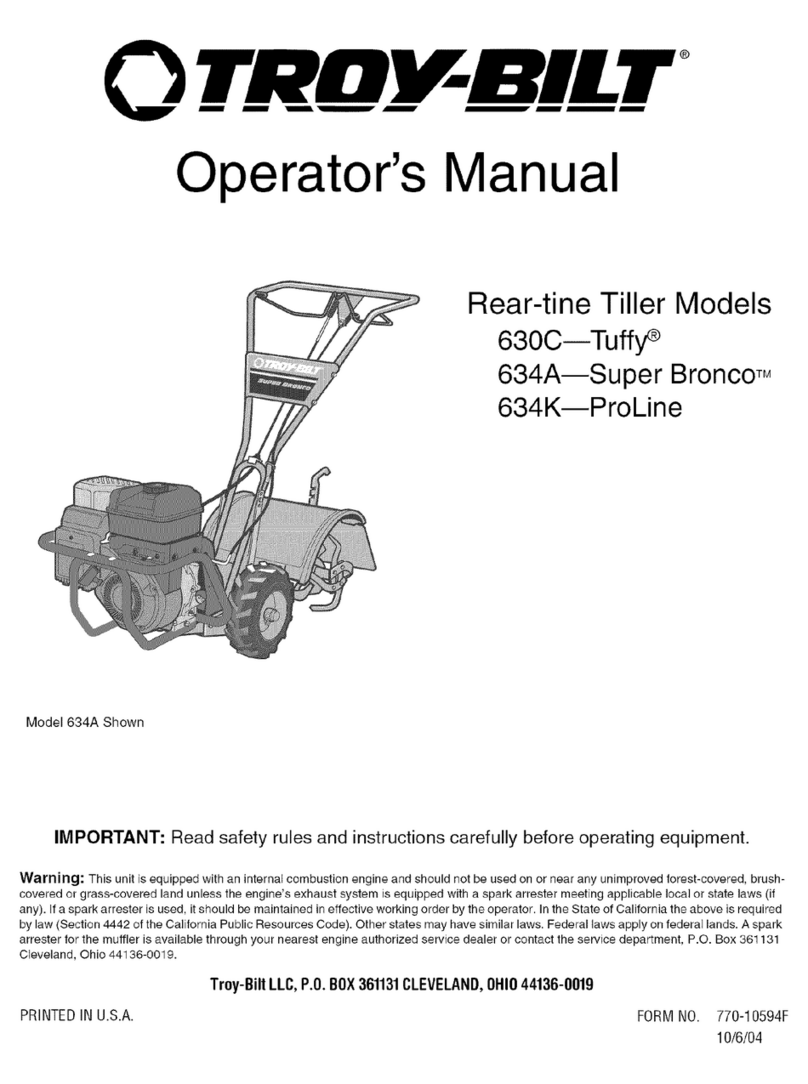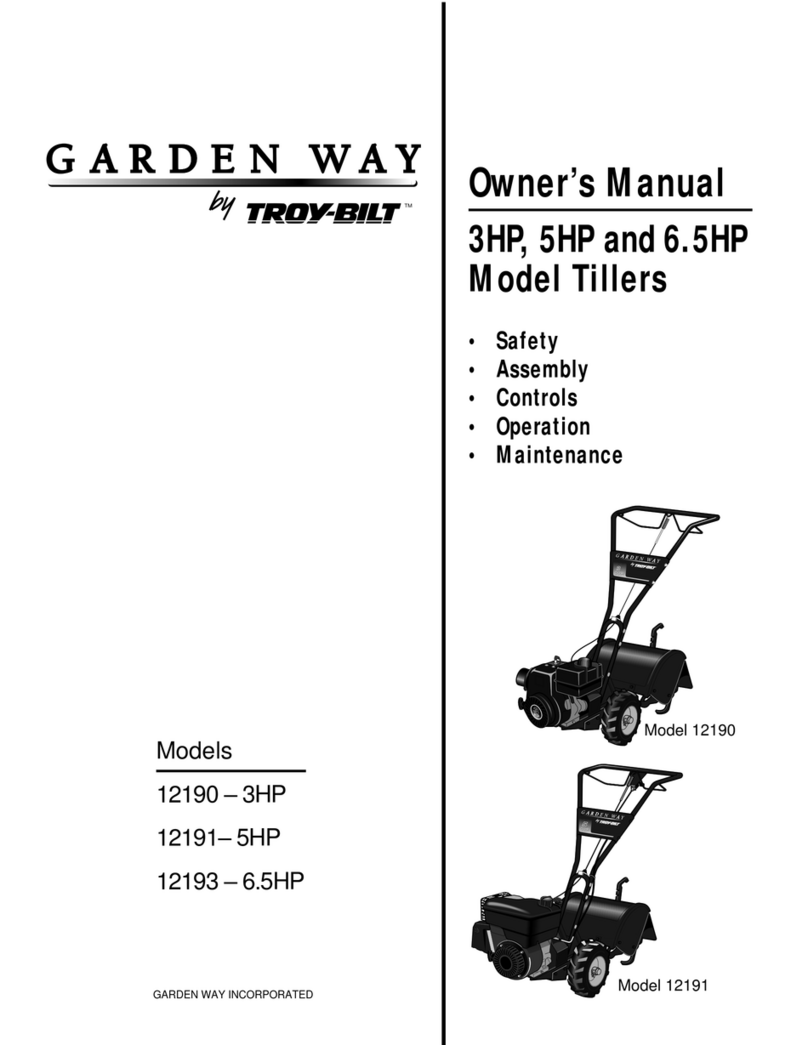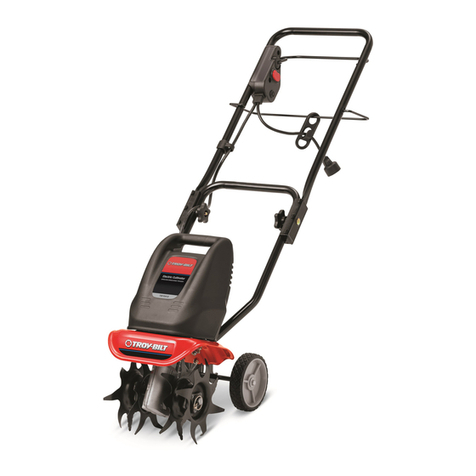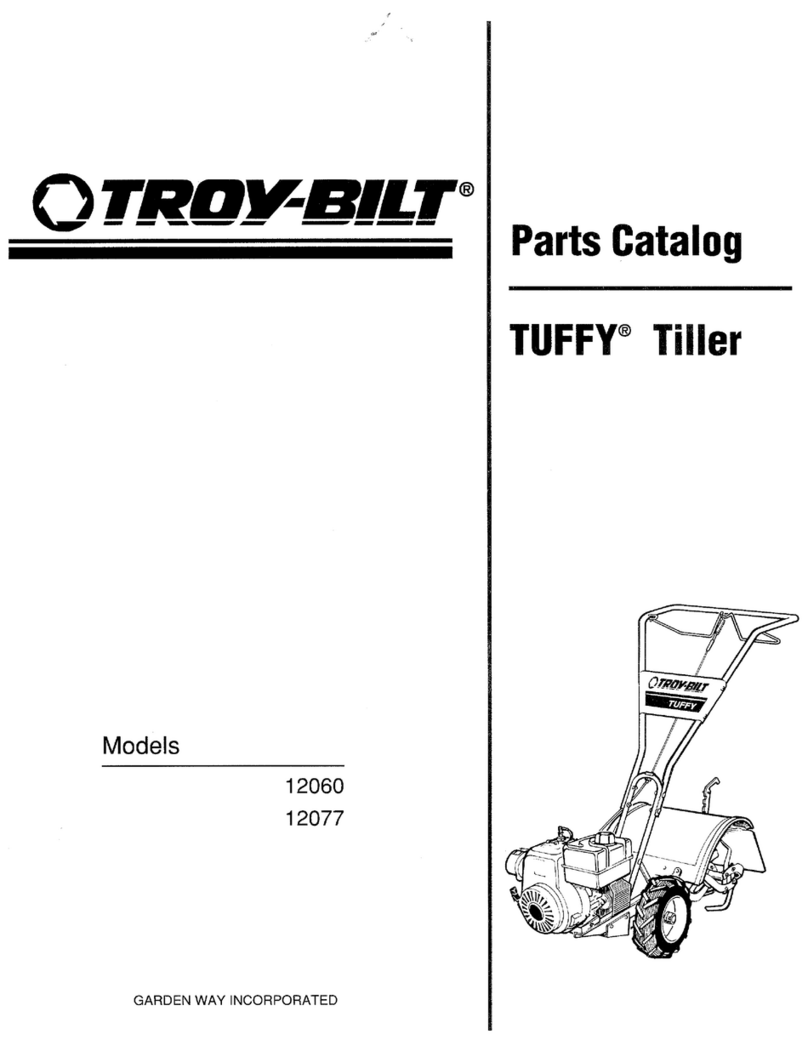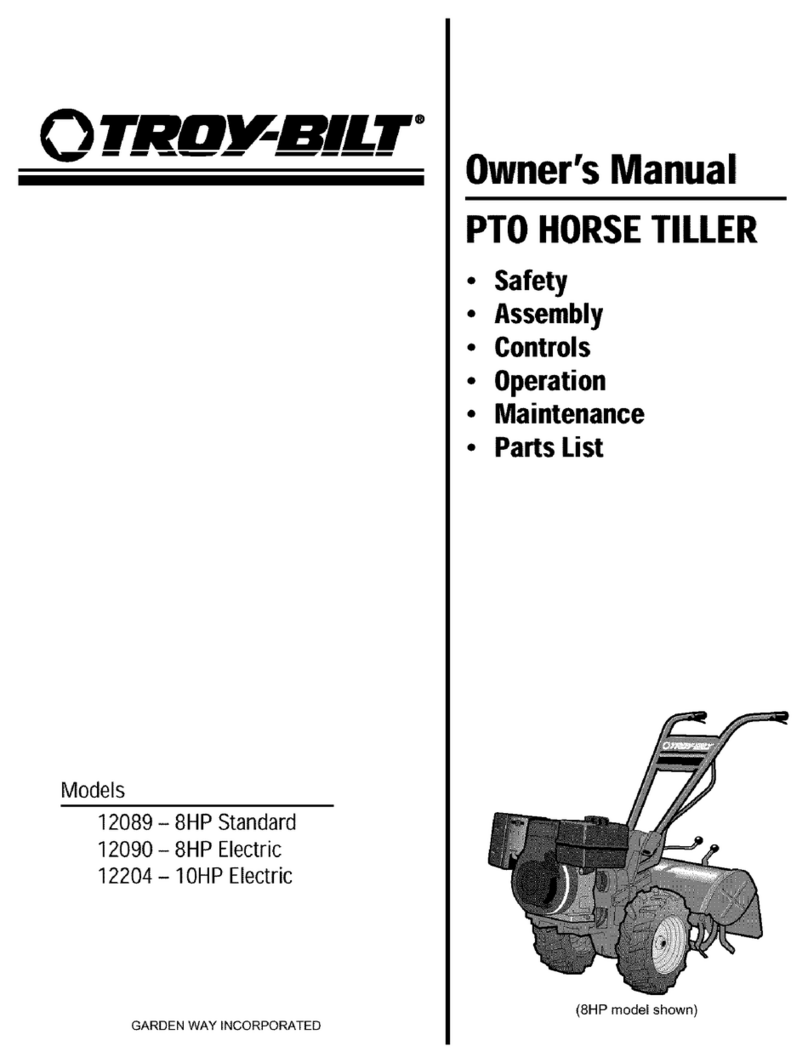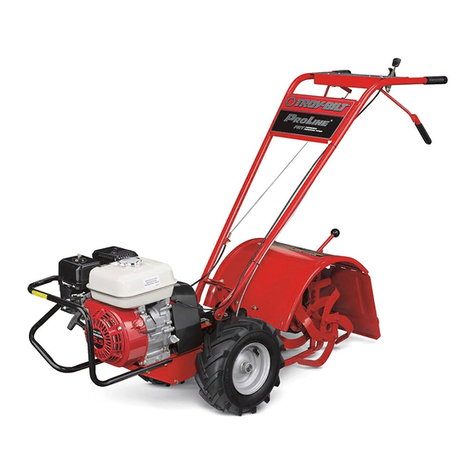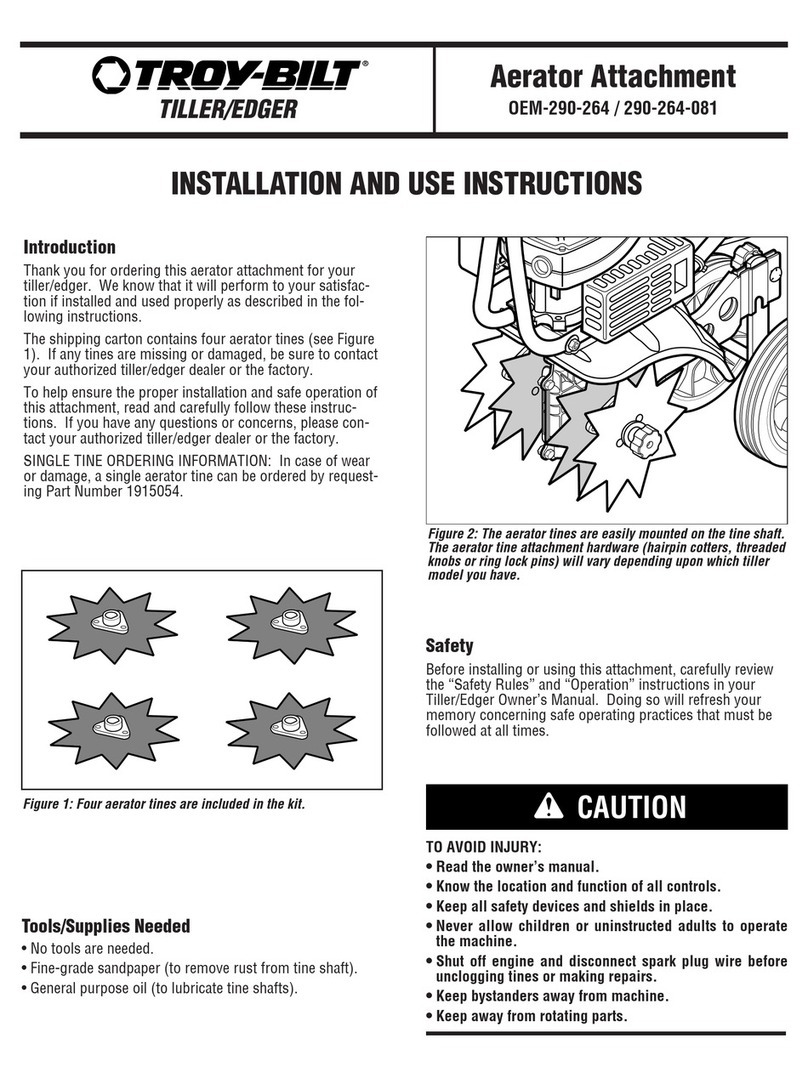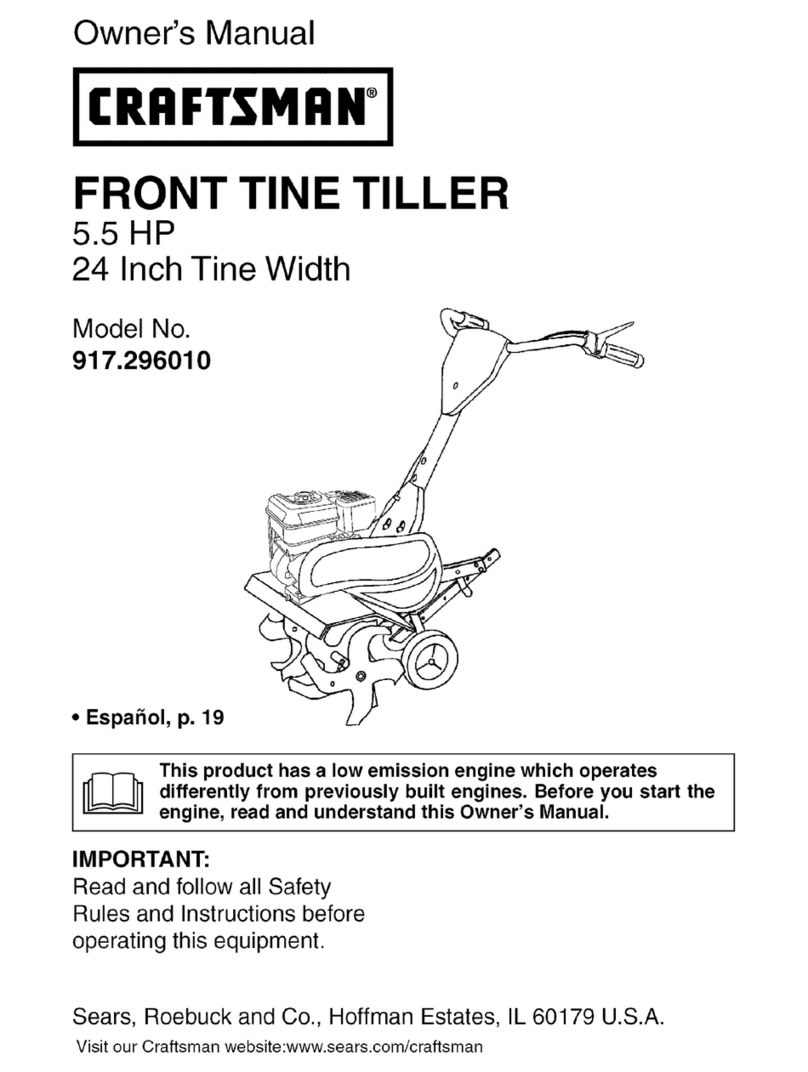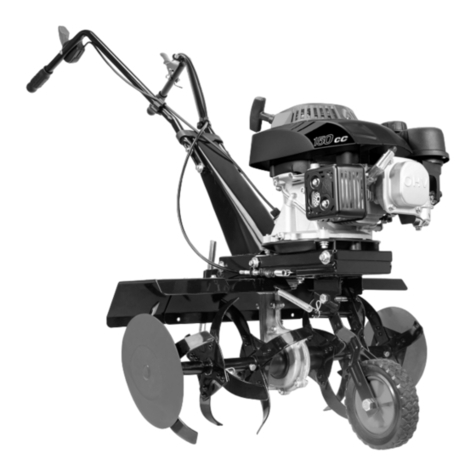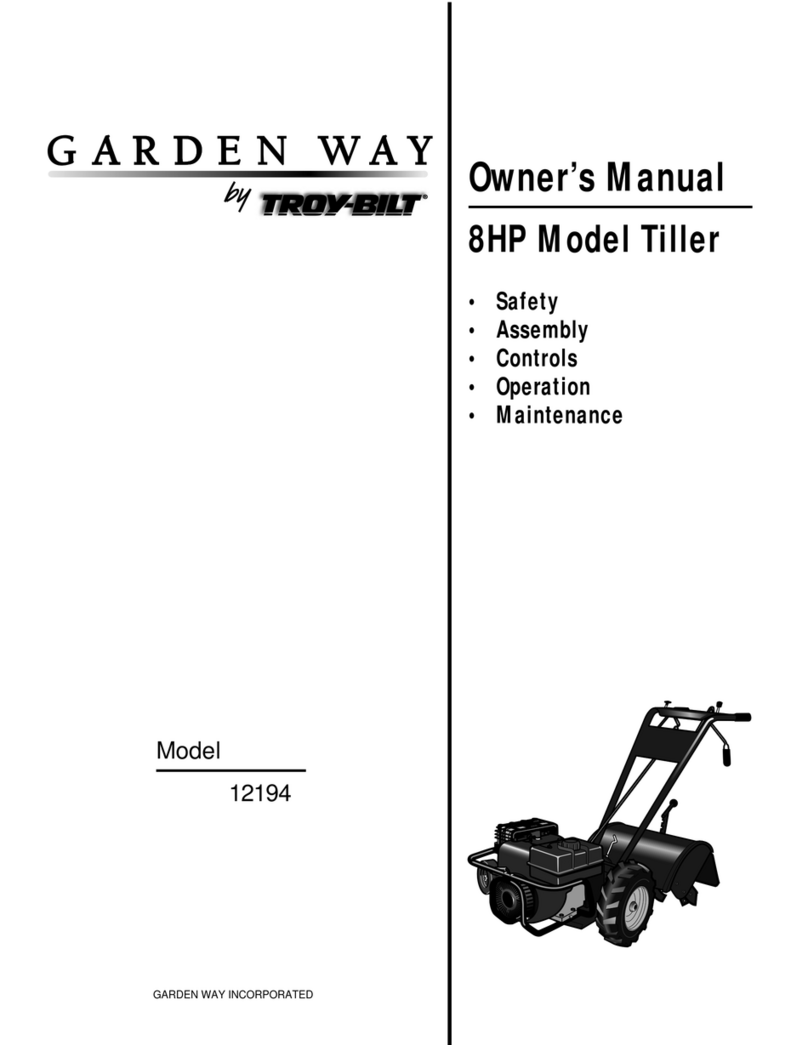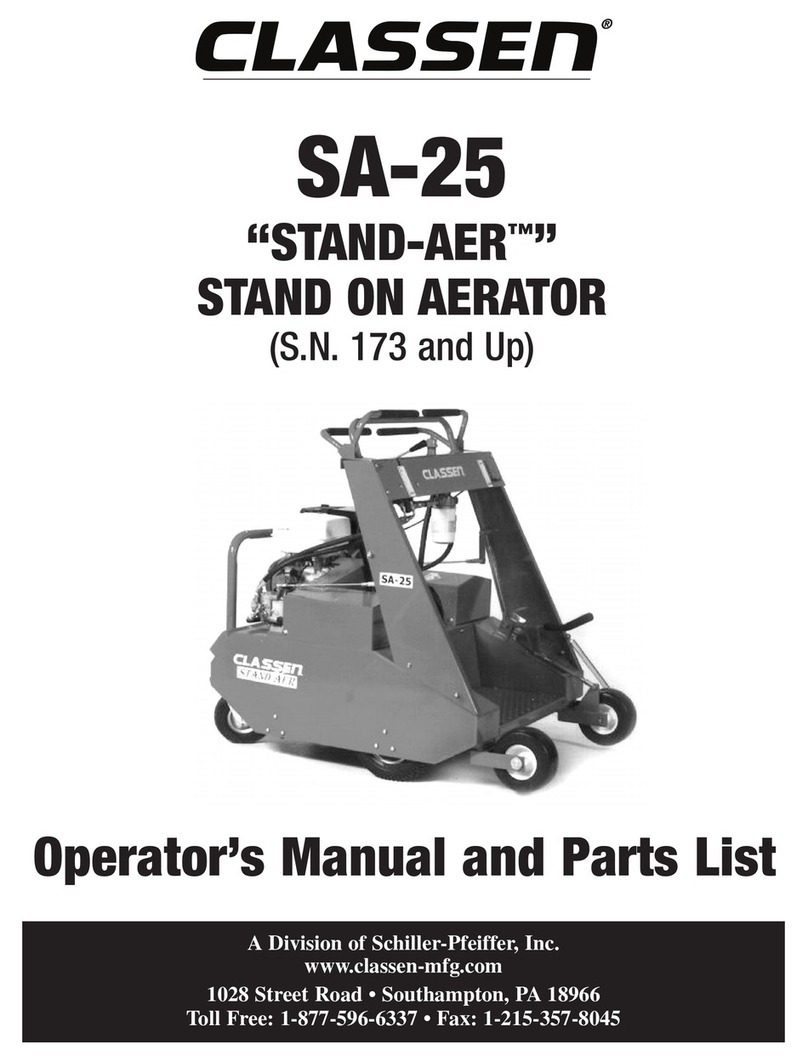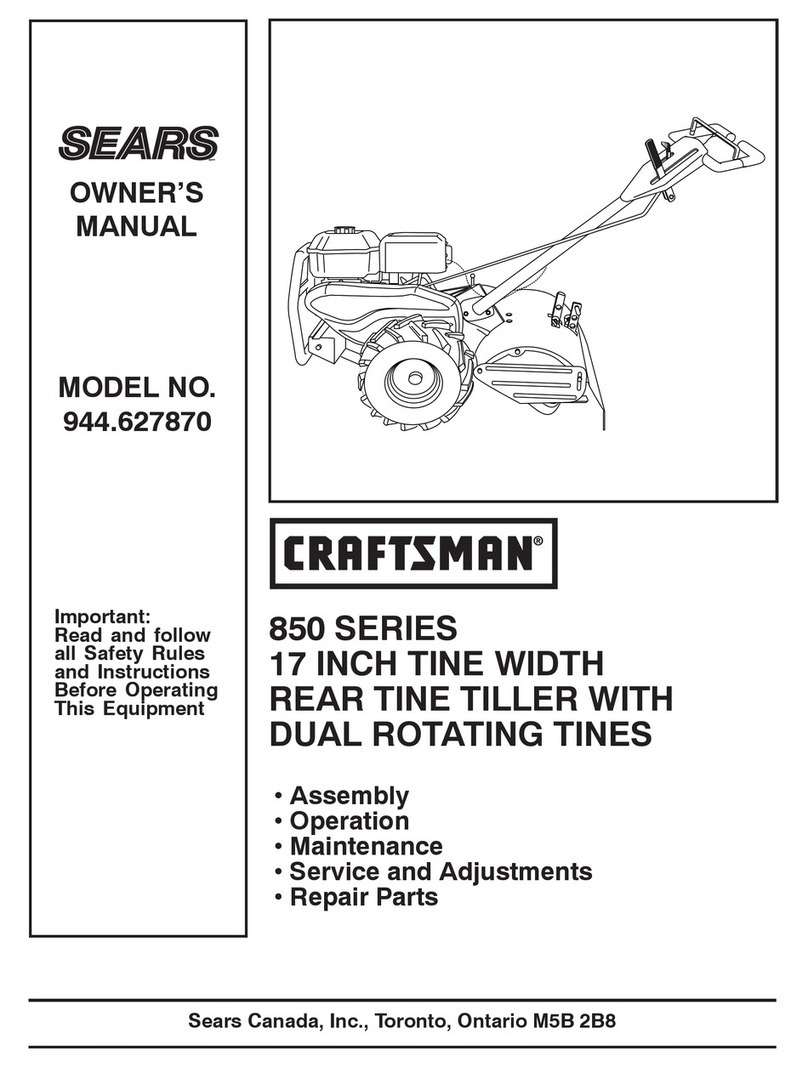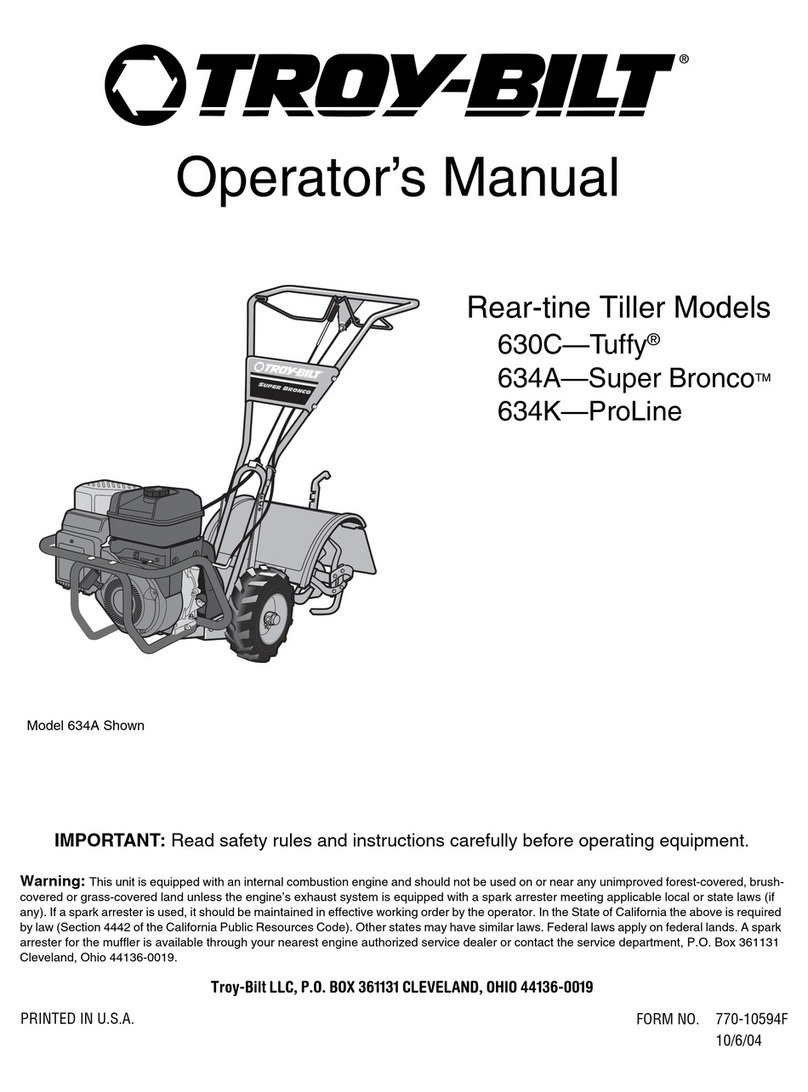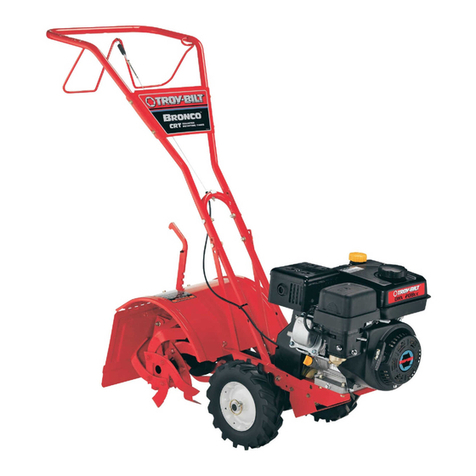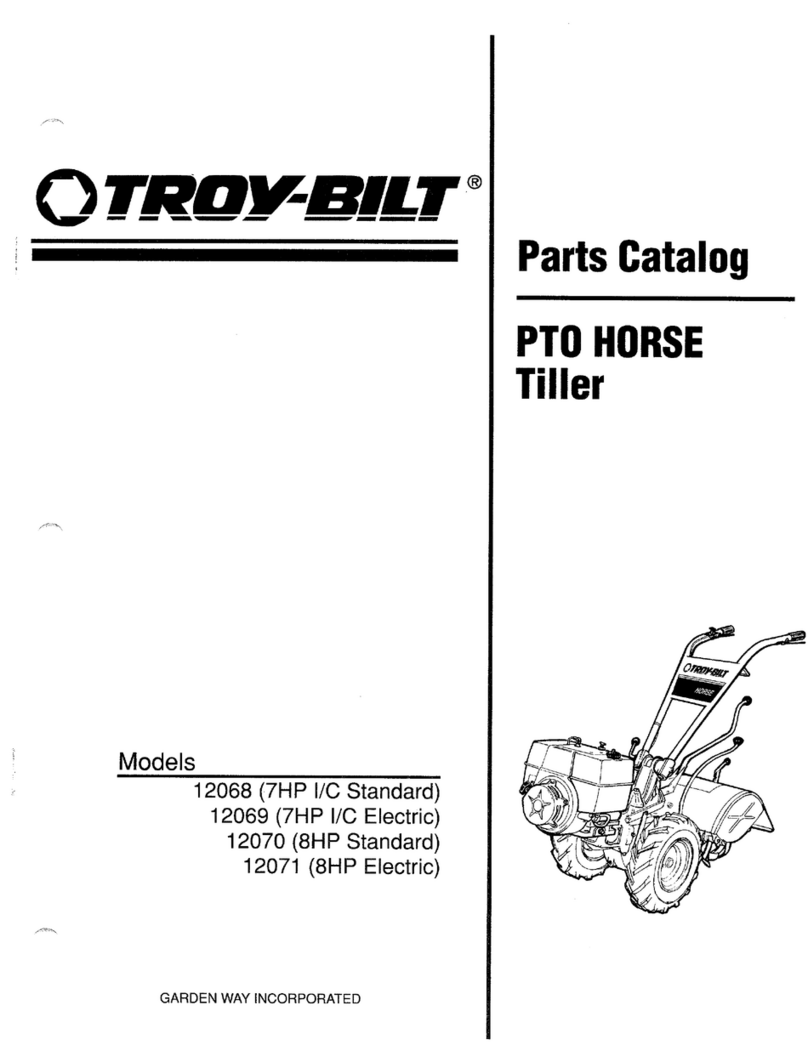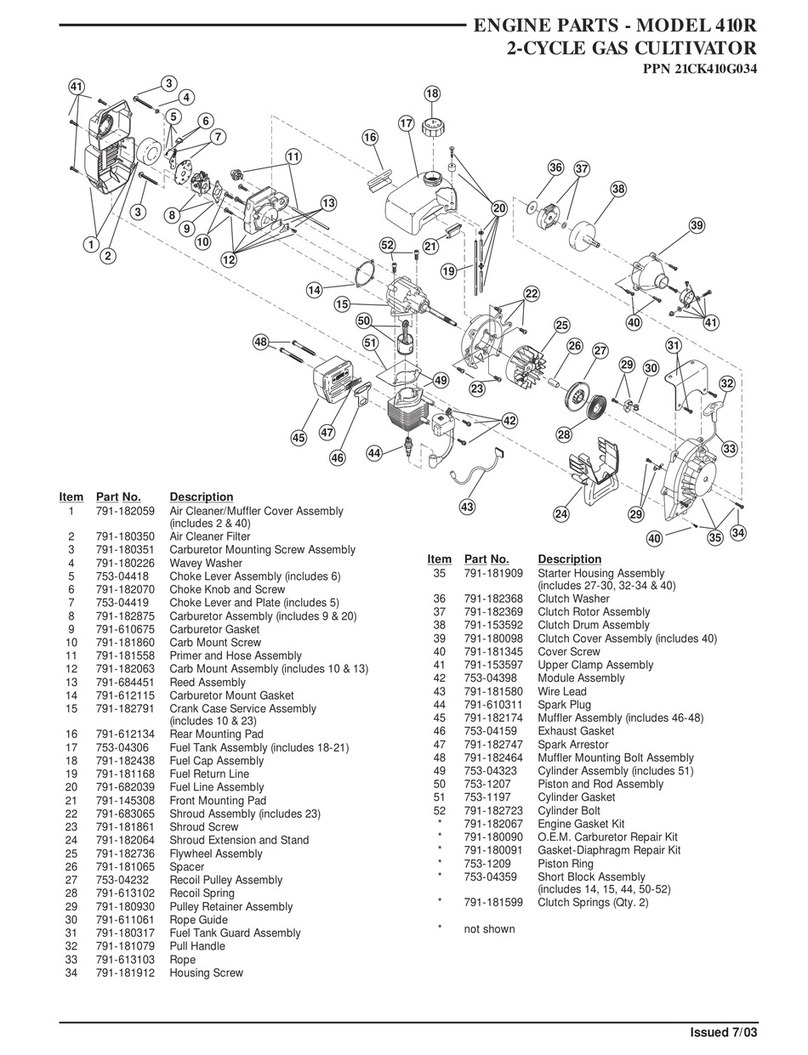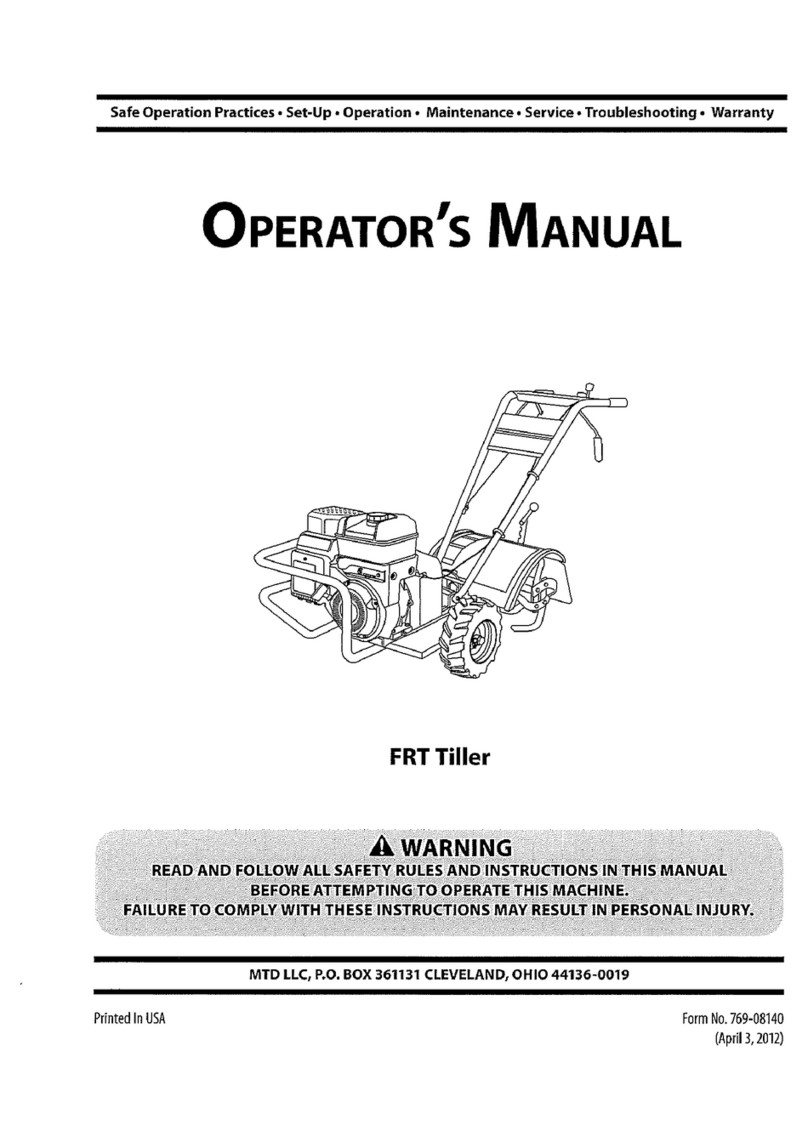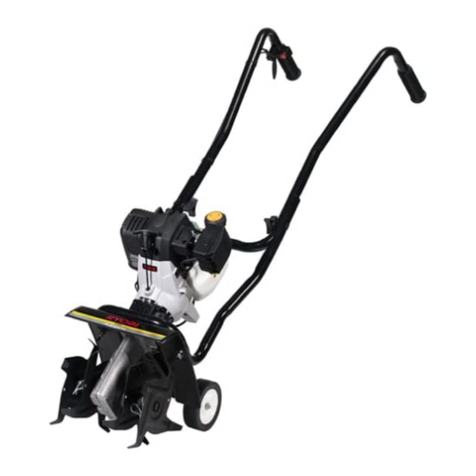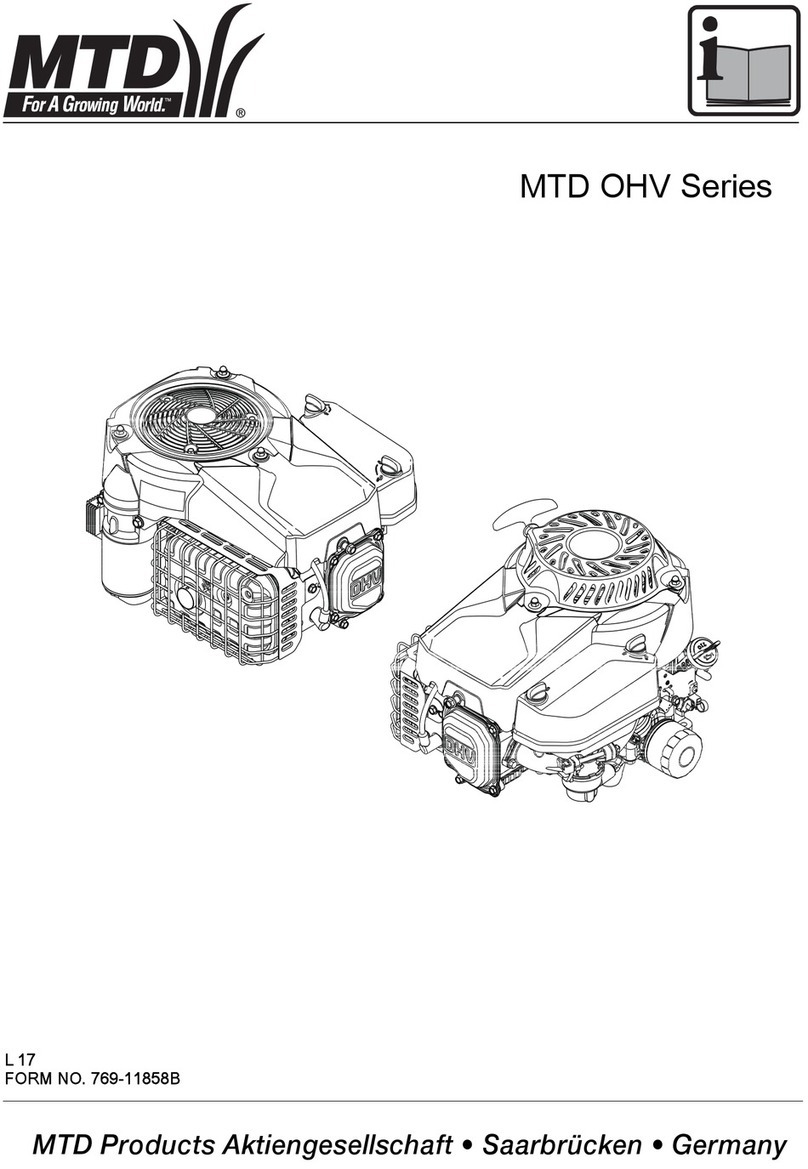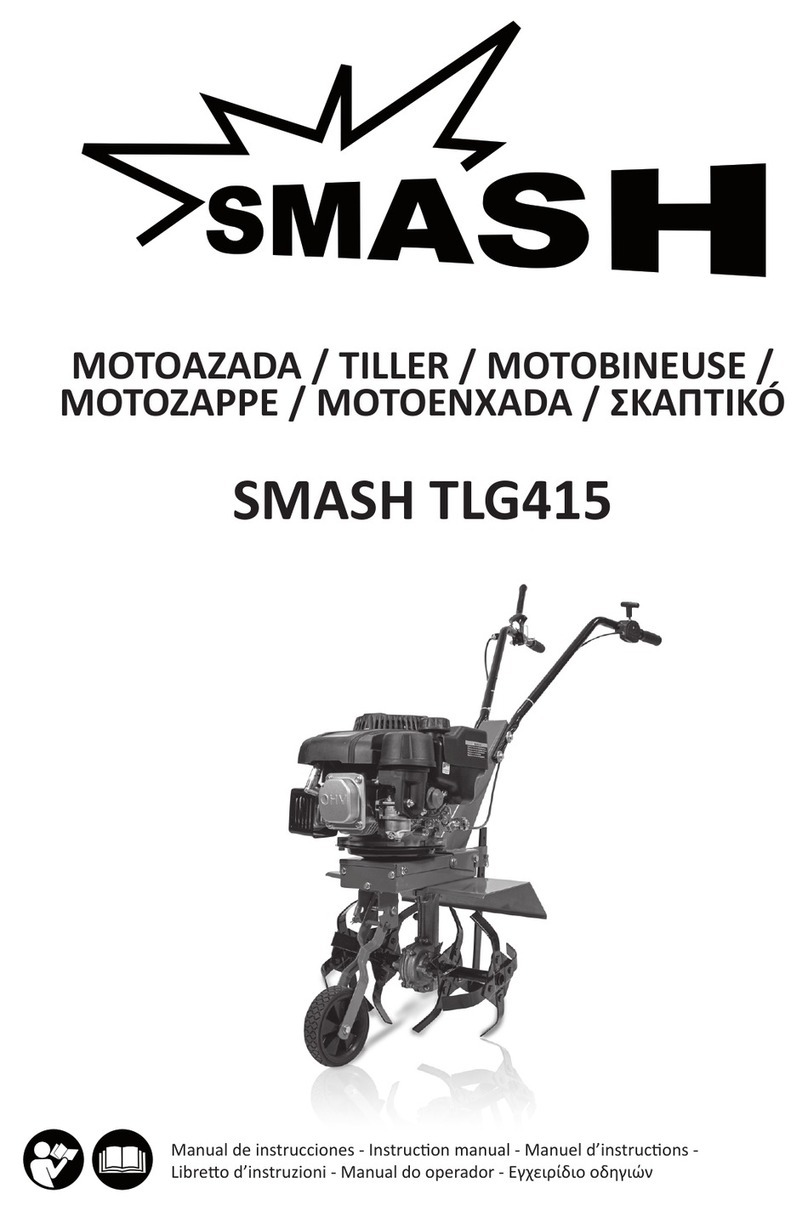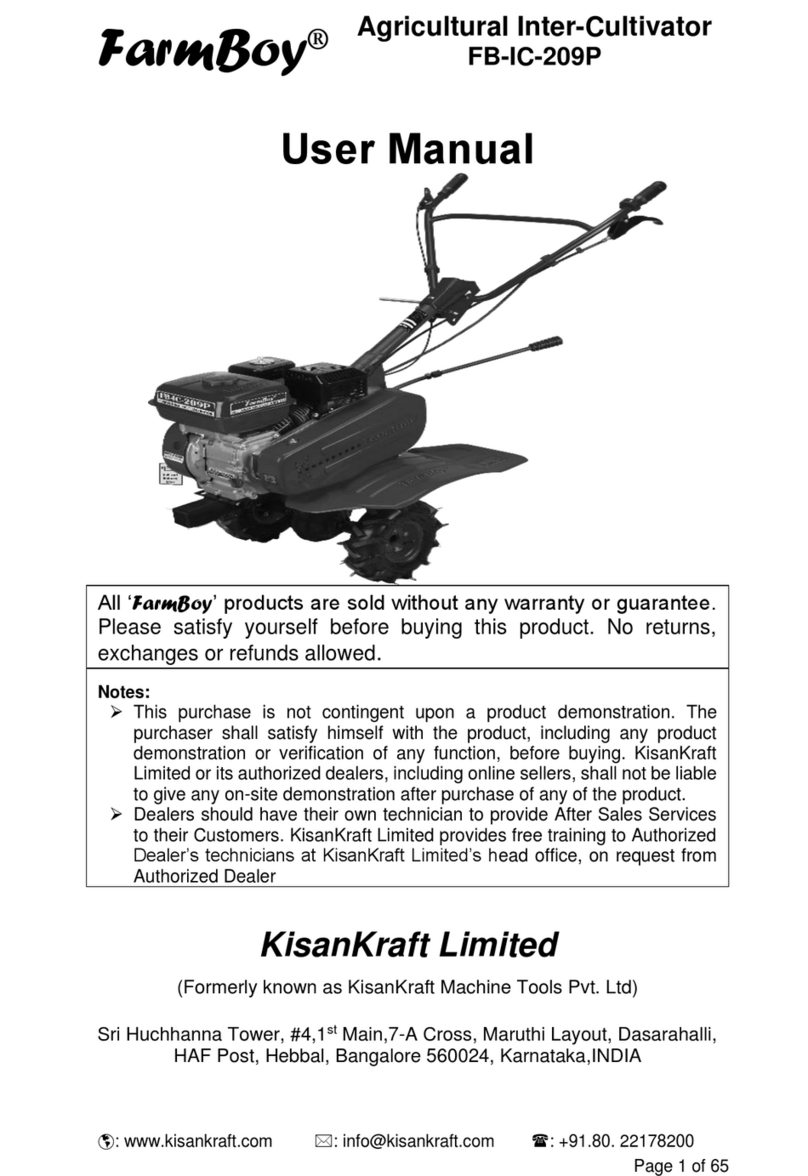7. Takeall possible precautionswhen
leavingthe machine unattended.Stop the
engine. Removeignition key on electric
start models. Disconnectspark plug wire
and move it awayfrom thespark plug.
MoveWheel GearLeverto ENGAGE.
8. Beforecleaning, repairing, or inspect-
ing,stop the engine,remove the ignition
keyon electric start models,and make
certain all moving parts havestopped.
Disconnectthe spark plug wire and
prevent itfrom touching the spark plug to
preventaccidentalstarting. On electric
start models,always removethe cable
from the negativeside (-) ofthe battery.
9. Always keepthe tiller tine hood flap
down, unlessusing the hiller/furrower
attachment.
lB. Never usethe tiller unless proper
guards, plates,or othersafetyprotective
devicesare in place.
11. Do not run engine in an enclosed
area.Engineexhaustcontains carbon
monoxide gas,a deadlypoisonthat is
odorless,colorless, and tasteless.
12. Keepchildren and pets away.
13. Never operatethetiller under
enginepoweriftheWheel GearLever is
in DISENGAGE(FREEWHEEL).In this
position,thewheels will not holdthe
tiller backandthe revolvingtines could
propelthetiger rapidly, possibly
causinglossofcontrol.Always movethe
WheelGearLeverto ENGAGEbefore
starting theengine or engagingthe
tines/wheelswith the ForwardClutch
Control or the ReverseClutchControl.
14. Beawarethatthe tiller may unex-
pectedlybounceupwardor jump
forwardif thetines shouldstrike
extremelyhardpackedsoil, frozen
ground,or buriedobstacleslike large
stones,roots,or stumps.If in doubt
aboutthe tilling conditions,alwaysuse
thefollowingoperatingprecautionsto
assistyou in maintainingcontrolofthe
tiger:
a. Walk behindand toone sideofthe
tiller, usingone handon thehan-
dlebars. Relaxyourarm, butusea
securehandgrip.
b. Useshallowerdepthregulatorset-
tings, workinggraduallydeeper
with eachpass.
c. Useslowerenginespeeds.
d. Clearthetilling area ofall large
stones,rootsandotherdebris.
e. Avoidusingdownwardpressure
on handlebars.If needbe, use
slightupwardpressuretokeepthe
tinesfrom diggingtoodeeply.
f. Beforecontactinghardpackedsoil
at the endofa row, reduceengine
speedand lift handlebarstoraise
tinesout ofthesoil.
g. In an emergency,stoptines and
wheelsbyreleasingwhichever
ClutchLever isengaged.Do not
attemptto restrainthetiller.
15. Do not overloadthetiller's capacity
by attempting to till too deeplyat too fast
a rate.
16. Neveroperatethe tiller at high trans-
port speedson hard or slippery surfaces.
Look behind and usecarewhen backing
up.
17. Do not operatethe tiller on a slope
that istoo steepfor safety.When on
slopes, slow down and makesureyou
havegood footing. Never permit the tiller
to freewheeldown slopes.
18. Neverallow bystanders nearthe unit.
19. Onlyuseattachments and acces-
sories that areapproved bythe tiller
manufacturer.
20. Usetiller attachments and acces-
sories when recommended.
21. Neveroperatethetiller without good
visibility or light.
22. Neveroperatethetiller ifyouaretired,
or underthe influenceof alcohol,drugsor
medication.
23. Operatorsshallnottamperwith the
engine-governorsettingson themachine;
thegovernorcontrolsthe maximumsafe
operatingspeedto protectthe engineand
all movingpartsfrom damagecausedby
overspeed.Authorizedserviceshallbe
soughtif a problemexists.
24. Donottouch enginepartswhich may
be hotfrom operation.Letpartscooldown
sufficiently.
25. Thebatteryon electricstartmodeltillers
containssulfuricacid.Avoidcontactwith
skin,eyes,or clothing.Keepout ofthe
reachofchildren.
Antidote-External Contact:Flushimme-
diatelywith lots of water.
Antidote-Internal: Drinklargequantities
ofwateror milk.Followwith milk of
magnesia,beateneggs or vegetableoil.
Calla doctor immediately.
Antidote-EyeContact:Flushwith water
for 15 minutes.Getpromptmedical
attention.
26. Batteriesproduceexplosivegases.Keep
sparks,flame,andsmoking materialsaway.
Ventilatewhenchargingbatteriesor when
usingabatteryin an enclosedspace.
ALWAYSwearsafetygoggleswhen
working nearbatteries.
27. Pleaseremember:You canalwaysstop
thetinesand wheelsby releasingthe
ForwardClutchControlLeveror the
ReverseClutchControlknob(whichever
controlyou haveengaged),or by moving
theEngineThrottleControlLever(located
onengine)to STOPon recoilstartmodels
or byturningthe ignitionkeyto OFFon
electricstartmodels.
28. Toloador unloadthetiller, seethe
instructionsinSection4 ofthis Manual.
29. Useextremecautionwhen reversingor
pullingthemachinetowardsyou.
30. Starttheenginecarefullyaccordingto
instructionsandwith feetwellawayfrom
thetines.
31. Neverpick up or carrya machinewhile
theengineis running.
MAINTENANCEANDSTORAGE
1. Keepthe tiller, attachments and acces-
sories in safeworking condition.
2. Checkall nuts, bolts, and screws at
frequent intervalsfor proper tightness to
besure the equipment is in safeworking
condition.
3. Neverstorethetillerwith fuel in thefuel
tankinsidea buildingwhereignition
sourcesarepresentsuchashotwaterand
spaceheaters,furnaces,clothesdryers,
stoves,electricmotors,etc. Allowengineto
coolbeforestoring in anyenclosure.
